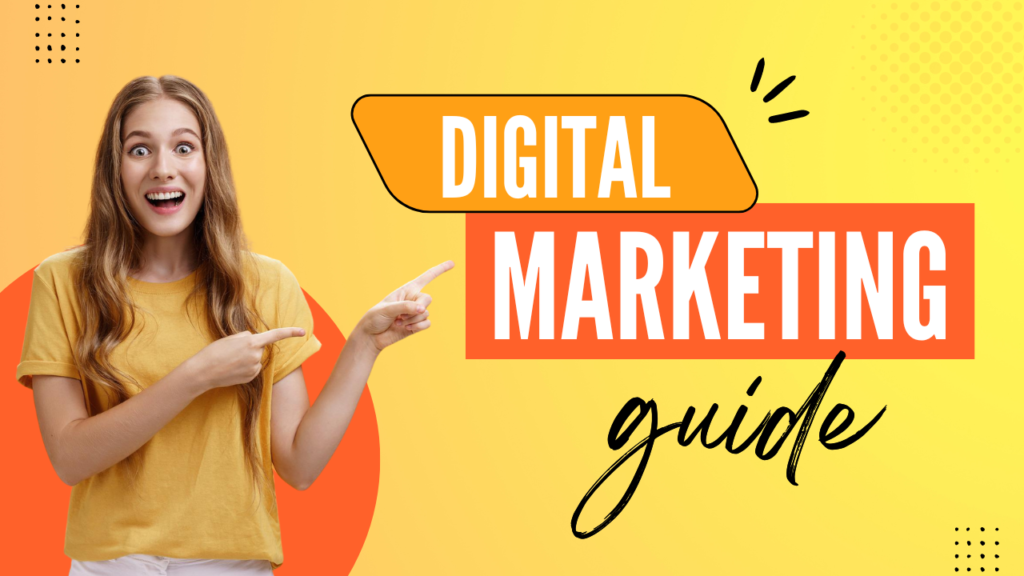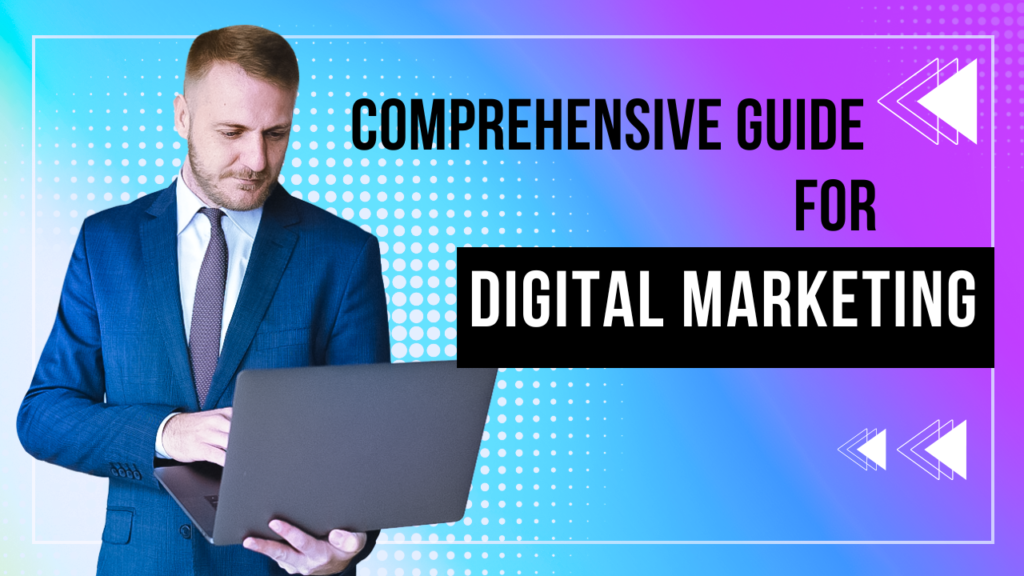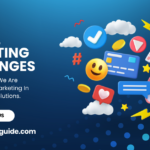Welcome to the age of Digital Marketing, where marketing strategies are as dynamic as the technologies driving them. As we step into 2024, the landscape of digital marketing continues to evolve at a rapid pace, influenced by emerging trends, consumer behaviors, and technological advancements. In this comprehensive guide, we’ll delve into the strategies, tools, and tactics that will define successful digital marketing campaigns in 2024.

Table of Contents
Understanding the Digital Landscape
- Explore Current Trends:
1.1. AI and Automation: Definition: Artificial intelligence (AI) and automation technologies are transforming digital marketing by automating repetitive tasks, analyzing vast amounts of data, and personalizing customer experiences.
Implications: Marketers can leverage AI-powered tools for tasks such as email marketing automation, content personalization, chatbots for customer service, and predictive analytics for campaign optimization.
Example: Chatbots deployed on websites and social media platforms can provide instant responses to customer queries, improving user experience and reducing response times.
1.2. Video Dominance:
Definition: Video content continues to dominate digital platforms, capturing audience attention and driving engagement.
Implications: Marketers should prioritize video content creation across platforms like YouTube, Instagram, TikTok, and LinkedIn to convey brand messages effectively and engage with audiences visually.
Example: Brands can create engaging video content such as product demonstrations, behind-the-scenes footage, user-generated content, and storytelling videos to connect with their audience emotionally.
1.3. Voice Search Optimization:
Definition: With the proliferation of voice-activated devices like smart speakers and virtual assistants, optimizing for voice search is essential for improving search engine visibility.
Implications: Marketers need to optimize website content and incorporate natural language keywords and phrases to align with voice search queries.
Example: Optimizing FAQ pages with conversational language and providing concise answers to common questions can improve chances of appearing in voice search results.
1.4. Privacy and Data Regulations:
Definition: Stricter data privacy regulations such as GDPR and CCPA, along with growing consumer privacy concerns, emphasize the importance of transparent data practices and compliance.
Implications: Marketers must prioritize data privacy and security, obtain explicit consent for data collection and usage, and adhere to regulatory requirements to maintain consumer trust.
Example: Implementing robust data protection measures, such as encryption, anonymization, and secure data storage, helps ensure compliance with regulations and protect customer data from unauthorized access or breaches.
- Assess Consumer Behavior:
2.1. Digital Consumption Habits: Definition: Understanding how consumers interact with digital platforms, devices, and content informs marketing strategies and messaging.
Implications: Marketers should analyze consumer behavior data to identify preferred channels, content types, and engagement patterns, enabling targeted and personalized marketing efforts.
Example: Analyzing website traffic, social media engagement metrics, and email open rates can reveal insights into audience preferences and behaviors, guiding content creation and distribution strategies.
2.2. Mobile and Multi-Device Usage:
Definition: The widespread adoption of smartphones and tablets has transformed how consumers access and interact with digital content, necessitating mobile-friendly marketing strategies.
Implications: Marketers should prioritize mobile optimization for websites, emails, ads, and content to provide seamless experiences across devices and capitalize on mobile traffic.
Example: Implementing responsive web design, optimizing email campaigns for mobile viewing, and creating mobile-first ad creatives enhance user experience and engagement on mobile devices.
2.3. Content Consumption Preferences:
Definition: Consumers prefer personalized, relevant content that resonates with their interests, preferences, and needs.
Implications: Marketers should create and distribute content tailored to specific audience segments, addressing their pain points, interests, and aspirations to drive engagement and conversions.
Example: Segmenting email lists based on subscriber preferences and behavior, and delivering targeted content recommendations based on browsing history and purchase behavior, can increase engagement and conversions.
- Analyze Competitor Strategies:
3.1. Competitive Landscape: Definition: Analyzing competitor strategies provides insights into industry trends, best practices, and areas of opportunity or differentiation.
Implications: Marketers should research competitors’ digital marketing tactics, messaging, positioning, and audience engagement strategies to benchmark performance and identify competitive advantages.
Example: Conducting competitor analysis using tools like SEMrush, Ahrefs, or SpyFu to identify top-performing keywords, ad creatives, and content strategies, and leveraging these insights to refine and optimize your own marketing efforts.
3.2. Industry Trends and Innovations:
Definition: Monitoring industry trends and innovations helps marketers stay ahead of the curve and adapt strategies to evolving consumer preferences and market dynamics.
Implications: Marketers should stay updated on emerging technologies, consumer behavior shifts, regulatory changes, and competitive developments to capitalize on opportunities and mitigate risks.
Example: Subscribing to industry newsletters, attending conferences and webinars, and participating in online communities and forums facilitate knowledge sharing and networking, fostering innovation and thought leadership within the industry.
3.3. SWOT Analysis:
Definition: Conducting a SWOT (Strengths, Weaknesses, Opportunities, Threats) analysis helps assess internal capabilities, external factors, and market dynamics to inform strategic decision-making.
Implications: Marketers should identify strengths to leverage, weaknesses to address, opportunities to pursue, and threats to mitigate, aligning marketing strategies with organizational goals and market realities.
Example: Analyzing internal strengths such as brand reputation, product quality, and marketing expertise, external opportunities such as emerging market segments or partnership opportunities, weaknesses such as limited resources or competitive disadvantages, and threats such as market saturation or disruptive technologies, guides strategic planning and resource allocation.
Crafting a Digital Marketing Strategy
- Define Objectives:
1.1. Setting Clear Goals: Definition: Establishing clear and specific objectives is crucial for guiding digital marketing efforts and measuring success.
Implications: Marketers should define SMART (Specific, Measurable, Achievable, Relevant, Time-bound) goals aligned with overall business objectives, such as increasing brand awareness, generating leads, driving sales, or improving customer retention.
Example: Setting a goal to increase website traffic by 20% within six months, or to achieve a 15% increase in online sales by the end of the fiscal year, provides a clear direction for marketing initiatives. - Identify Target Audience:
2.1. Audience Segmentation: Definition: Segmenting the target audience based on demographics, psychographics, behavior, and preferences allows for more personalized and targeted marketing efforts.
Implications: Marketers should conduct market research and data analysis to identify distinct audience segments with unique needs, interests, and pain points, enabling tailored messaging and content.
Example: Segmenting the audience into groups such as age, gender, location, income level, interests, purchase history, and engagement level helps create targeted campaigns and messaging that resonate with each segment. - Develop Content Strategy:
3.1. Content Planning: Definition: Developing a content strategy involves planning and creating compelling and relevant content to engage the target audience and achieve marketing objectives.
Implications: Marketers should align content with audience needs and preferences, brand messaging, and marketing objectives, considering various content formats such as blog posts, videos, infographics, podcasts, and social media posts.
Example: Creating a content calendar outlining topics, formats, publishing schedules, and distribution channels helps maintain consistency and alignment with overall marketing goals. - Choose Channels and Platforms:
4.1. Channel Selection: Definition: Selecting the most appropriate digital channels and platforms involves identifying where the target audience is most active and receptive to marketing messages.
Implications: Marketers should consider factors such as demographics, behavior, platform popularity, engagement trends, and industry norms when choosing channels for marketing campaigns.
Example: Selecting channels such as Facebook, Instagram, LinkedIn, TikTok, YouTube, email, search engines, and niche forums or communities based on audience preferences and campaign objectives maximizes reach and engagement. - Allocate Budget and Resources:
5.1. Budget Planning: Definition: Allocating budget resources effectively ensures optimal allocation of funds across various marketing channels and activities to achieve desired outcomes.
Implications: Marketers should prioritize budget allocation based on ROI potential, audience reach, channel effectiveness, and campaign objectives, considering factors such as ad costs, content production expenses, and technology investments.
Example: Allocating a larger budget to channels with higher conversion rates or ROI, such as paid search or retargeting ads, while allocating smaller budgets to experimental or emerging channels allows for efficient resource utilization and risk management.
Leveraging Social Media Platforms
- Choose Relevant Platforms:
1.1. Audience Analysis: Definition: Analyzing your target audience’s demographics, behaviors, and preferences helps identify the social media platforms where they are most active and engaged.
Implications: Marketers should conduct audience research to understand which social media platforms resonate most with their target demographic, considering factors such as age, gender, interests, and online behavior.
Example: If your target audience comprises primarily young adults aged 18-34, platforms like Instagram, TikTok, and Snapchat may be more effective for reaching and engaging them. - Create Engaging Content:
2.1. Content Strategy: Definition: Developing a content strategy involves planning and creating compelling and relevant content tailored to each social media platform’s format and audience preferences.
Implications: Marketers should create diverse content types, such as images, videos, stories, polls, and interactive posts, to capture audience attention and drive engagement.
Example: Posting visually appealing product photos, behind-the-scenes videos, user-generated content, and interactive polls or quizzes helps maintain audience interest and encourages interaction. - Leverage Influencer Partnerships:
3.1. Influencer Identification: Definition: Identifying influencers relevant to your brand and target audience involves researching individuals or content creators with a significant following and influence within your industry or niche.
Implications: Marketers should identify influencers whose values, interests, and audience align with their brand, considering factors such as reach, engagement rate, authenticity, and relevance.
Example: Collaborating with influencers to create sponsored content, host giveaways, or endorse products can help expand reach, build credibility, and drive conversions among their followers. - Engage with Your Audience:
4.1. Community Management: Definition: Engaging with your audience involves actively responding to comments, messages, and mentions, fostering meaningful conversations, and building relationships with followers.
Implications: Marketers should monitor social media channels regularly, respond promptly to inquiries and feedback, and encourage user-generated content and discussions to foster a sense of community.
Example: Responding to customer queries, thanking users for positive feedback, addressing concerns or complaints, and sharing user-generated content helps strengthen brand-consumer relationships and loyalty. - Analyze Performance:
5.1. Metrics Tracking: Definition: Tracking key performance metrics helps assess the effectiveness of social media campaigns, measure engagement, and identify areas for improvement.
Implications: Marketers should track metrics such as reach, engagement (likes, comments, shares), click-through rate (CTR), conversion rate, and return on investment (ROI) to evaluate campaign performance and inform strategic decisions.
Example: Using social media analytics tools like Facebook Insights, Instagram Insights, or Twitter Analytics to track and analyze performance metrics, identify top-performing content, and optimize future campaigns based on insights.
focuses on embracing emerging technologies in digital marketing
- Stay Updated:
1.1. Emerging Technologies: Definition: Staying updated on emerging technologies involves keeping abreast of new tools, platforms, and innovations shaping the digital marketing landscape.
Implications: Marketers need to stay informed about advancements in areas such as artificial intelligence (AI), augmented reality (AR), virtual reality (VR), blockchain, and 5G technology to capitalize on new opportunities and stay competitive.
Example: Keeping track of industry publications, attending conferences, participating in webinars, and joining relevant online communities or forums help marketers stay informed about emerging technologies and trends. - Evaluate Applicability:
2.1. Relevance to Objectives: Definition: Assessing the relevance and potential impact of emerging technologies on marketing objectives and target audience needs.
Implications: Marketers should evaluate whether adopting new technologies aligns with their business goals, audience preferences, and marketing strategies, considering factors such as cost, scalability, and resource requirements.
Example: Assessing whether implementing AR-powered virtual try-on experiences aligns with the brand’s objective of enhancing the online shopping experience and increasing conversion rates among tech-savvy consumers. - Experiment and Innovate:
3.1. Test and Learn Approach: Definition: Embracing a culture of experimentation involves testing new technologies, strategies, and approaches to identify what works best for your brand and audience.
Implications: Marketers should adopt a test-and-learn mindset, experimenting with pilot projects, A/B testing, and iterative improvements to refine strategies and optimize performance.
Example: Launching a pilot AR marketing campaign to gauge customer response, collecting feedback, analyzing performance metrics, and iterating based on insights to improve effectiveness and ROI. - Measure Results:
4.1. Performance Evaluation: Definition: Measuring the results and impact of initiatives leveraging emerging technologies to assess effectiveness and ROI.
Implications: Marketers should track key performance indicators (KPIs) relevant to each technology implementation, such as engagement metrics, conversion rates, cost per acquisition, and customer satisfaction, to evaluate success and inform future decisions.
Example: Analyzing metrics such as time spent interacting with AR experiences, conversion rates on VR-enhanced product pages, or blockchain-based loyalty program participation rates to gauge the effectiveness and ROI of each technology investment.
focuses on measuring and optimizing the performance of digital marketing efforts
- Define Metrics:
1.1. Key Performance Indicators (KPIs): Definition: Identifying the key metrics that align with your marketing objectives and provide insights into campaign performance.
Implications: Marketers should define KPIs such as website traffic, conversion rate, click-through rate (CTR), engagement rate, return on investment (ROI), customer acquisition cost (CAC), and customer lifetime value (CLV) to track and measure success.
Example: If the goal is to increase brand awareness, KPIs might include metrics like reach, impressions, and social media mentions. For lead generation, KPIs could include form submissions, downloads, or email sign-ups. - Implement Tracking Tools:
2.1. Analytics Platforms: Definition: Utilizing analytics tools and platforms to collect and analyze data from various marketing channels and touchpoints.
Implications: Marketers should implement tracking pixels, tags, and analytics software such as Google Analytics, Adobe Analytics, or Facebook Pixel to monitor website traffic, user behavior, campaign performance, and conversion attribution.
Example: Installing Google Analytics on your website to track visitor demographics, traffic sources, page views, and conversion funnels provides valuable insights into user engagement and behavior. - Analyze Data:
3.1. Data Insights: Definition: Analyzing data collected from tracking tools to gain insights into audience behavior, campaign performance, and market trends.
Implications: Marketers should conduct regular data analysis to identify patterns, trends, and correlations, uncovering opportunities for optimization and improvement.
Example: Analyzing website traffic sources to identify which channels drive the most visitors and conversions, or examining email campaign performance to determine which subject lines or content types resonate best with subscribers. - Optimize Campaigns:
4.1. Continuous Improvement: Definition: Iteratively refining marketing campaigns based on data-driven insights and performance feedback.
Implications: Marketers should use A/B testing, experimentation, and iterative optimization techniques to refine targeting, messaging, creative assets, and campaign tactics for maximum effectiveness.
Example: Testing different ad creatives, headlines, and calls-to-action to determine which variations yield the highest click-through rates and conversion rates, then scaling the winning elements for broader deployment. - Iterate and Improve:
5.1. Iterative Process: Definition: Embracing a continuous improvement mindset to iteratively refine marketing strategies and tactics based on performance feedback and market dynamics.
Implications: Marketers should regularly review campaign performance, identify areas for improvement, implement optimizations, and iterate on strategies to adapt to changing consumer behavior and market conditions.
Example: Reviewing campaign performance weekly or monthly, identifying underperforming elements or missed opportunities, implementing adjustments, and testing new approaches to achieve better results in subsequent iterations.
Conclusion:
As we navigate the digital frontier in 2024, staying ahead of the curve requires a strategic approach, agility, and a willingness to embrace innovation. By understanding the latest trends, leveraging emerging technologies, and prioritizing data-driven decision-making, marketers can create impactful campaigns that resonate with audiences and drive business growth in the ever-evolving digital landscape.








